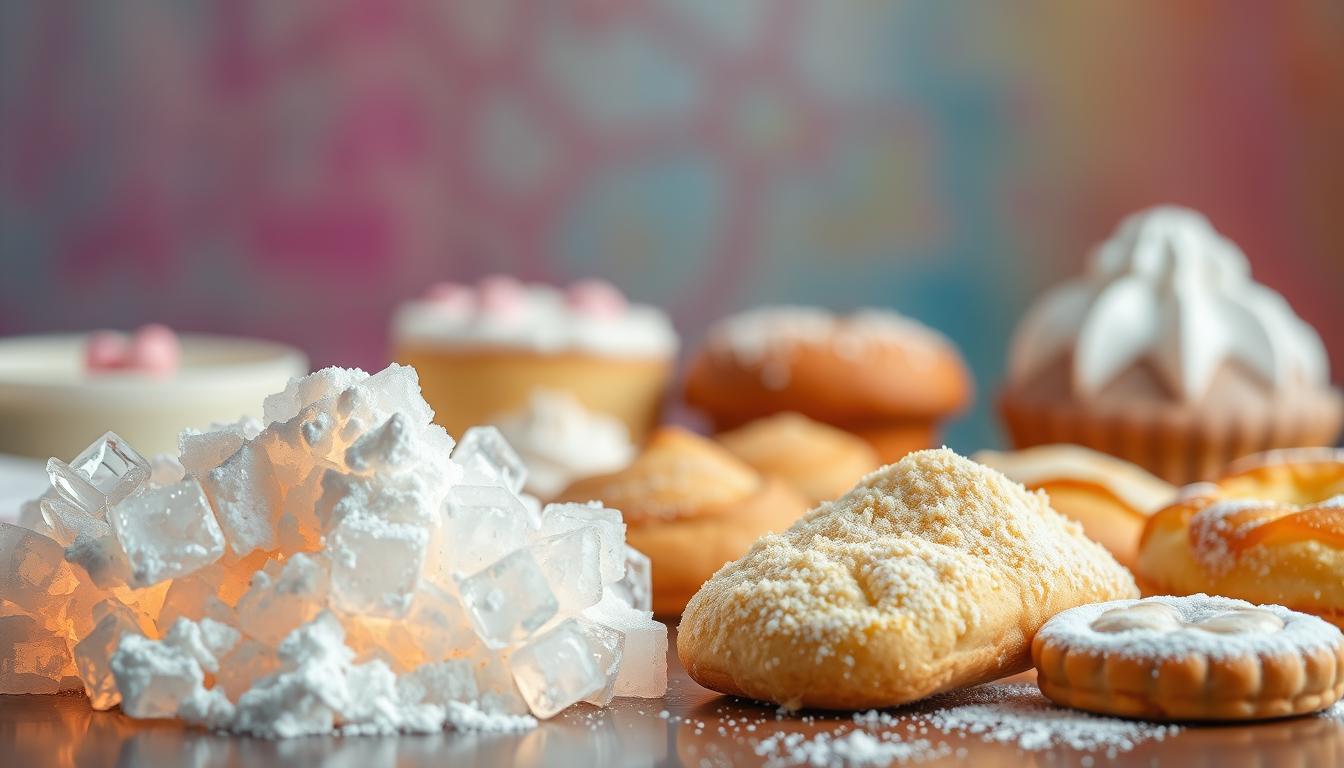Did you know that over 60% of failed baked goods result from using the wrong leavening agent? These kitchen staples may look similar, but their chemistry couldn’t be more distinct. Choosing the correct one determines whether your cake rises perfectly or collapses into a dense mess.
Both baking soda and baking powder release carbon dioxide to lift batters. However, their activation methods split them into two categories. The former requires an acidic partner—like yogurt or vinegar—to trigger its leavening power. The latter contains built-in acid, allowing it to work in recipes without added tang.
Swap them carelessly, and you risk a metallic aftertaste or uneven texture. Timing also matters. For example, baking soda reacts immediately when mixed with acid, while baking powder activates in stages during baking. This difference affects everything from muffin domes to cookie spread.
Key Takeaways
- Baking soda needs acidic ingredients to activate; baking powder contains its own acid.
- Substituting one for the other without adjustments leads to texture and flavor issues.
- Reaction timing impacts rise and structure in baked goods.
- Using the wrong leavening agent can cause flat or dense results.
- Professional bakers prioritize precise measurements for consistent outcomes.
Understanding the Role of Leavening Agents
Ever wonder why your pancakes puff up or your muffins get their signature dome? The secret lies in leavening agents—the unsung heroes that transform dense batters into airy delights. These ingredients create gas bubbles, causing mixtures to expand during baking. Without them, cakes would resemble bricks, and cookies would stay flat.

What Are Leavening Agents?
Leavening agents are substances that release gas to lift doughs and batters. They fall into three categories:
| Type | Activation Method | Examples |
|---|---|---|
| Chemical | Acid-base reactions | Baking soda, baking powder |
| Biological | Yeast fermentation | Active dry yeast, sourdough starter |
| Physical | Air/steam expansion | Whipped egg whites, folded butter |
Common Uses in Baking
Chemical leaveners like baking powder shine in quick breads and cakes, where instant rise matters. Baking soda pairs with acidic ingredients in chocolate cakes or tangy buttermilk biscuits. Yeast works overtime in crusty breads, while whipped egg whites give soufflés their cloud-like texture.
Choosing the right agent depends on your recipe’s pH and timing needs. A cookie recipe might use only soda, while a vanilla cake could require both soda and powder for balanced lift. Get it right, and your treats will rise to the occasion every time.
The Chemistry of Baking Soda and Baking Powder
While flour and sugar form the backbone of baked goods, their rise depends on precise chemical partnerships. Let’s break down what happens at the molecular level when these leaveners meet your batter.
Chemical Properties Explained
Baking soda is pure sodium bicarbonate—an alkaline compound that sits inert until activated. When mixed with acidic ingredients like lemon juice or yogurt, it instantly releases carbon dioxide gas. This reaction explains why pancake batter bubbles the moment you stir in buttermilk.

Baking powder combines sodium bicarbonate with cream of tartar (a dry acid) and cornstarch. The cornstarch absorbs moisture during storage, preventing premature reactions. Unlike its single-ingredient counterpart, this blend contains everything needed for lift except liquid and heat.
How Carbon Dioxide Is Produced
When you add water to baking powder, the sodium bicarbonate and cream of tartar dissolve. This triggers an acid-base reaction, creating carbon dioxide bubbles. Most commercial varieties are double-acting, meaning they release gas twice: first during mixing, then again when oven heat expands air pockets.
In recipes using pure sodium bicarbonate, the reaction happens immediately. That’s why cookie dough with vinegar or honey spreads faster—the gas forms before baking begins. Timing these reactions correctly ensures proper structure, whether you’re making tender muffins or crisp snickerdoodles.
How Baking Soda and Baking Powder React Differently
Your oven timer isn’t the only clock ticking when working with leaveners. The countdown starts the moment moisture hits your ingredients. Baking soda acts like a sprinter—exploding into action immediately when meeting acids. Wait too long to bake, and those precious bubbles vanish, leaving dense cookies or sunken cakes.

Race Against the Clock
Single-acting powder behaves like its soda counterpart, creating instant lift. This works well for recipes going straight into the oven. Double-acting varieties offer a safety net. Their first reaction occurs during mixing, while heat triggers the second rise. You gain flexibility—no need to rush batters from bowl to baking sheet.
| Leavener | First Reaction | Second Reaction | Best Used For |
|---|---|---|---|
| Baking Soda | Immediate (acid contact) | None | Quick-bake items like pancakes |
| Single-Acting Powder | Mixing bowl | None | Recipes baked immediately |
| Double-Acting Powder | Mixing bowl | Oven heat | Cakes, muffins, delayed baking |
Professional bakers choose leaveners based on workflow needs. Soda demands speed—perfect for thin batters that spread fast. Double-acting powder suits layered cakes needing gradual rise. Ever noticed cookie recipes specifying “bake immediately”? That’s soda at work, losing power by the minute.
Your recipe’s instructions reveal which reaction type you’re handling. Batters using pure sodium bicarbonate often skip resting steps. Those with modern powders might allow prep-ahead flexibility. Match your pace to the leavener’s timeline for consistently airy results.
Smart Substitutions in Your Recipes
Picture this: you’re halfway through mixing cookie dough when you realize you’re out of baking powder. Don’t panic—strategic swaps can save your dessert. While original formulas work best, these conversions help when pantry supplies run low.

Converting Baking Soda to Baking Powder
Since baking soda is 3-4 times stronger than its counterpart, substitutions require careful math and added acid. Use this formula:
- 1 tsp baking powder = ¼ tsp soda + ½ tsp cream of tartar
- No cream of tartar? Substitute 1 tsp lemon juice or white vinegar
Mix these with dry ingredients first to prevent premature reactions. The acid activates the soda, mimicking commercial powder’s dual-action lift.
Adjusting Recipes with Substitutes
Reversing the swap needs different math. Replace 1 tsp soda with 3 tsp powder—but only if the recipe lacks acidic components. Citrus additions might require reducing sugar to balance tartness.
Remember:
- Lemon juice adds moisture—reduce other liquids slightly
- Vinegar leaves no taste when baked properly
- Excess cream of tartar creates a metallic aftertaste
While these fixes work in a pinch, they alter texture and browning. For birthday cakes or delicate pastries, stick to the original recipe. Your taste buds—and dinner guests—will thank you.
Impact on Flavor, Texture, and Appearance
The golden crust on your chocolate chip cookies or pale elegance of a vanilla sponge cake isn’t accidental—it’s science in action. Leavening agents shape not just rise, but every sensory detail of your creations.
Effects on Color and Browning
Baking soda acts as a pH powerhouse. By alkalizing batters, it accelerates Maillard reactions—the chemical process responsible for golden crusts and complex flavors. This makes it ideal for chocolate cakes and banana bread, where deep caramelization enhances richness.
In cookies, soda reduces protein coagulation. This allows dough to spread before setting, creating chewy centers and crisp edges. Overdo it, though, and you’ll taste metallic notes or see uneven cracks.
| Agent | Color Impact | Texture Role | Flavor Risk |
|---|---|---|---|
| Baking Soda | Deep browning | Promotes spread | Metallic if overused |
| Baking Powder | Minimal change | Even rise | Bitter when excessive |
Baking powder keeps flavors neutral and colors light. Angel food cakes and sugar cookies rely on its subtle lift without altering delicate vanilla or citrus notes. Its double-acting formula ensures steady expansion, preventing collapsed centers.
Remember: ¼ tsp excess soda can overpower a recipe. With powder, measure precisely—too much leaves a chalky aftertaste. Match your leavener to both your ingredients and desired visual appeal for professional-grade results.
Balancing Acidity and Basicity in the Batter
A cake that refuses to rise or cookies tasting like metal often trace back to one issue—pH imbalance in your batter. Getting this balance right ensures proper gas production while avoiding unpleasant aftertastes.
The Importance of Acidic Ingredients
Acidic components like buttermilk or yogurt act as chemical partners for sodium bicarbonate. Without them, your baking soda remains inactive, resulting in dense textures. Common acids include:
- Tangy dairy (sour cream, cultured buttermilk)
- Natural sweeteners (honey, molasses)
- Cocoa powder or dark chocolate
Too little acid leaves unreacted sodium bicarbonate, creating a metallic flavor. Recipes with brown sugar or citrus juice often adjust soda amounts to match their acidity.
Managing pH Levels for Better Rise
Batters need precise acid-to-base ratios. For every ¼ tsp baking soda, include 1 cup acidic ingredient like buttermilk. Excess soda overwhelms available acids, while too little limits rise.
Commercial baking powder simplifies this by containing built-in acid. Its pre-measured formula activates with liquid and heat, making it ideal for neutral batters. Test your mix’s pH with strips if texture issues persist—ideal ranges between 6.5-7.5 ensure optimal reactions.



